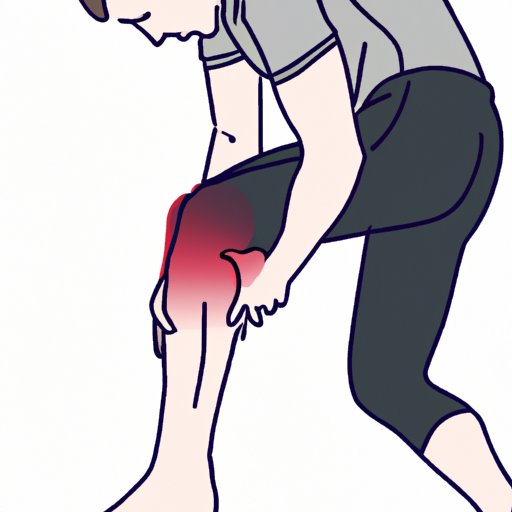
Introduction
Sciatic nerve pain is caused by irritation or compression of the sciatic nerve, which runs from the lower back down to the toes. This pain can be caused by a herniated disc, spinal stenosis, or even muscle spasms. It’s a common problem, and it’s important to treat and prevent it before it becomes more severe.
5 Easy and Effective Exercises to Relieve Sciatic Nerve Pain
One of the most effective ways to relieve sciatic nerve pain is through exercise. Here are some exercises that can help:
Knee-to-Chest Stretch
Lie on your back with your knees bent and your feet flat on the floor. Bring one knee up to your chest and hold it there with both hands. Hold for 30 seconds, then release and switch legs. Repeat this exercise three times on each side.
Pigeon Pose
Start on all fours and bring your right knee forward. Extend your left leg behind you and lower your body down to the ground, resting your right knee on the ground. Hold this stretch for 30 seconds, then release and switch sides. Repeat this exercise three times on each side.
These exercises can help to stretch and strengthen the muscles in your lower back and legs, which can help to relieve sciatic nerve pain.
Sciatic Nerve Pain: How Stretching Can Help Alleviate Discomfort
Stretching can also be an effective way to alleviate sciatic nerve pain. Here are some stretches to try:
Hamstring Stretch
Sit on the ground with your legs straight out in front of you. Reach forward with your hands towards your toes, keeping your back straight. Hold this stretch for 30 seconds, then release. Repeat this exercise three times.
Seated Spinal Twist
Sit on the ground with your legs crossed. Place your right hand on your left knee and your left hand on the ground behind you. Twist your torso to the left and hold for 30 seconds, then release and switch sides. Repeat this exercise three times on each side.
Stretching can help to improve flexibility, which can reduce pressure on the sciatic nerve and alleviate pain.
Science-Backed Methods to Reduce Sciatic Nerve Pain at Home
There are several science-backed methods that you can use at home to reduce sciatic nerve pain:
Heat Therapy
Applying heat to the affected area can help to increase blood flow, relax muscles, and reduce pain. You can use a hot compress or take a warm bath or shower to achieve this effect.
Cold Therapy
Applying cold to the affected area can help to reduce inflammation and numb the pain. You can use an ice pack or a bag of frozen vegetables wrapped in a towel to achieve this effect.
Over-the-Counter Pain Medication
Over-the-counter pain medication, such as ibuprofen or acetaminophen, can help to reduce inflammation and alleviate pain. Always follow the dosage instructions on the packaging.
These methods can help to reduce sciatic nerve pain at home, without the need for professional medical intervention.
From Hot Compresses to Essential Oils: Natural Remedies for Sciatic Nerve Pain
If you’re interested in natural remedies, there are several that can help to alleviate sciatic nerve pain:
Turmeric
Turmeric is a natural anti-inflammatory that can help to reduce inflammation and pain. You can take it as a supplement or use it in cooking.
Magnesium Supplements
Magnesium is a mineral that can help to relax muscles and reduce pain. You can take it as a supplement or eat magnesium-rich foods, such as nuts and leafy green vegetables.
Essential Oils
Essential oils, such as lavender and peppermint, can help to reduce inflammation, relax muscles, and alleviate pain. You can dilute them in a carrier oil and apply them topically or use an aromatherapy diffuser.
It’s important to note that natural remedies can have side effects and may interact with other medications. Always consult with a healthcare professional before using any natural remedies.
Sitting All Day? Here’s How to Prevent and Treat Sciatic Nerve Pain
Sitting for long periods of time can contribute to sciatic nerve pain. Here are some tips to prevent and treat pain from sitting:
Proper Posture
Sit with your back straight and your feet flat on the ground. Use a chair that supports your lower back, or use a cushion or rolled-up towel for support.
Breaks and Stretching
Take breaks every 20-30 minutes to stand up, stretch, and walk around. You can also do some of the exercises and stretches mentioned earlier to alleviate pain.
Expert Advice on How to Manage Chronic Sciatic Nerve Pain
If you’re experiencing chronic sciatic nerve pain, it’s important to seek medical treatment. Here are some treatment options that healthcare professionals may recommend:
Physical Therapy
Physical therapy can help to improve flexibility, strength, and mobility, which can reduce pressure on the sciatic nerve.
Prescription Medication
Prescription medication, such as muscle relaxants or opioids, may be necessary for severe cases of sciatic nerve pain.
Surgery
Surgery may be necessary in cases where other treatments have not been effective.
It’s important to work with a healthcare professional to find the best treatment plan for your individual needs.
Conclusion
Sciatic nerve pain can be a difficult and painful condition to deal with, but there are many effective ways to treat and prevent it. From exercises to stretching to science-backed methods and natural remedies, there are plenty of options to alleviate your pain and get back to living your life to the fullest. Remember to consult with a healthcare professional before starting any new treatment, and take actionable steps based on the advice in this article to start feeling better today.




